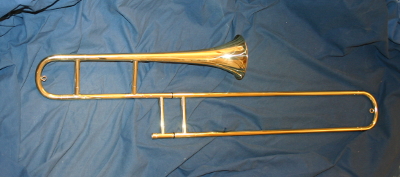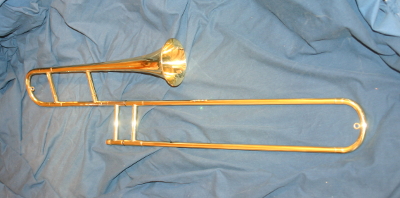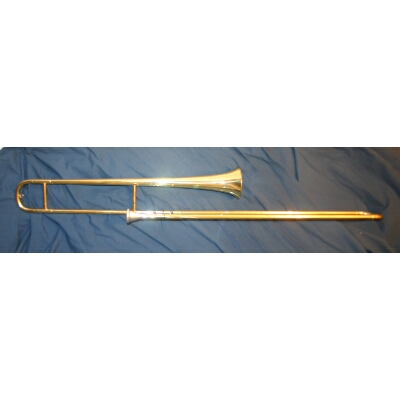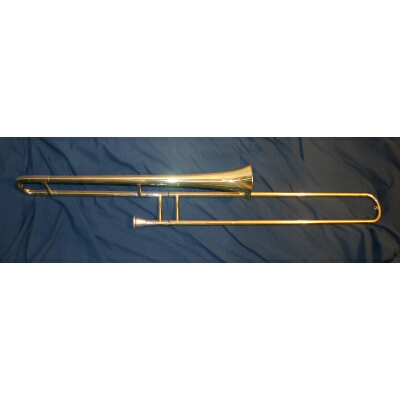
bout the Sackbut
 The sackbut is the forerunner of the modern trombone.
It differs from its modern incarnation in the shape of its bell, the thickness of its bell, the size of its bore, and the number and nature of its stays.
The bell of a sackbut does not flare as much as that of a trombone, and is much smaller (the bell on a tenor sackbut is approximately 10cm in diameter, while that of a tenor trombone can be larger than 18cm).
The shape of the sackbut's bell was characteristic of brass instruments of the period.
Contemporary trumpets had bells with a similar shape.
Musicologists of the 20th century including Curt Sachs and Thurston Dart stated that the walls of the sackbut are thicker than those of a trombone.
The walls of the tubing are approximately the same as that of the trombone.
However, the walls of the bell are thinner than that of the trombone.
The thin wall of the bell was supported by a garland that was often very ornate.
The bore of the sackbut is smaller than a modern trombone.
Most tenor sackbuts have a bore that is approximately 10mm in diameter.
The sackbut and trombone have two u-shaped bends in their tubing.
Stays are used to support the tubing, joining the two sides of each U section.
Prior to the seventeenth century, the stays on sackbuts were made from flat pieces of metal.
After that time, they were made from tubes of metal.
Historically accurate sackbuts have a single stay on the bell U section, whereas trombones have two or more.
The sackbut is the forerunner of the modern trombone.
It differs from its modern incarnation in the shape of its bell, the thickness of its bell, the size of its bore, and the number and nature of its stays.
The bell of a sackbut does not flare as much as that of a trombone, and is much smaller (the bell on a tenor sackbut is approximately 10cm in diameter, while that of a tenor trombone can be larger than 18cm).
The shape of the sackbut's bell was characteristic of brass instruments of the period.
Contemporary trumpets had bells with a similar shape.
Musicologists of the 20th century including Curt Sachs and Thurston Dart stated that the walls of the sackbut are thicker than those of a trombone.
The walls of the tubing are approximately the same as that of the trombone.
However, the walls of the bell are thinner than that of the trombone.
The thin wall of the bell was supported by a garland that was often very ornate.
The bore of the sackbut is smaller than a modern trombone.
Most tenor sackbuts have a bore that is approximately 10mm in diameter.
The sackbut and trombone have two u-shaped bends in their tubing.
Stays are used to support the tubing, joining the two sides of each U section.
Prior to the seventeenth century, the stays on sackbuts were made from flat pieces of metal.
After that time, they were made from tubes of metal.
Historically accurate sackbuts have a single stay on the bell U section, whereas trombones have two or more.
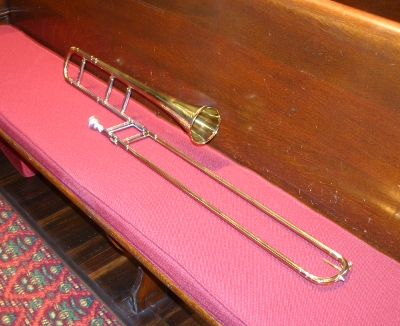 Sackbuts developed from trumpets during the fifteenth century.
With the addition of the slide they were able to play any pitch, something that the historical trumpet could not do.
They were known by many names.
Most of these were derived from a fifteenth century french term sacqueboute which meant push pull.
Thus in English they were called sackbut.
This was alternately spelled sackbutt, sackbutte, sacbut, sakbuds, sagbut, shagbolt, sacabushe, shakbusshe, seykebuds, shakebuttes, and shagbutts.
In Italian they were called trombone, meaning large trumpet.
In German they were known as posaune, from the French word buisine, a straight trumpet.
The term sackbut is commonly used to distinguish them from modern trombones.
Sackbuts developed from trumpets during the fifteenth century.
With the addition of the slide they were able to play any pitch, something that the historical trumpet could not do.
They were known by many names.
Most of these were derived from a fifteenth century french term sacqueboute which meant push pull.
Thus in English they were called sackbut.
This was alternately spelled sackbutt, sackbutte, sacbut, sakbuds, sagbut, shagbolt, sacabushe, shakbusshe, seykebuds, shakebuttes, and shagbutts.
In Italian they were called trombone, meaning large trumpet.
In German they were known as posaune, from the French word buisine, a straight trumpet.
The term sackbut is commonly used to distinguish them from modern trombones.
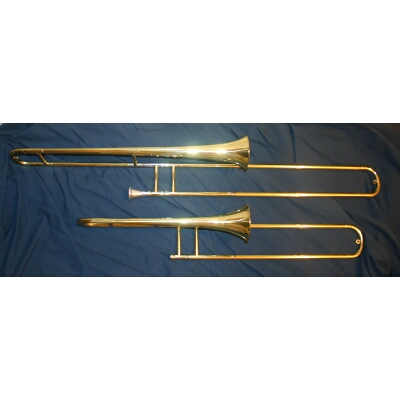 During the sixteenth century sackbuts were made in three sizes, alto, tenor, and bass.
The lowest note on the alto sackbut was f.
The lowest note on the tenor sackbut was Bb.
The lowest note on the bass sackbut was Eb.
It is worth noting that these pitches become e A and D if they are tuned at A=466.
The alto was sometimes tuned in eb and the bass in F.
During the sixteenth century sackbuts were made in three sizes, alto, tenor, and bass.
The lowest note on the alto sackbut was f.
The lowest note on the tenor sackbut was Bb.
The lowest note on the bass sackbut was Eb.
It is worth noting that these pitches become e A and D if they are tuned at A=466.
The alto was sometimes tuned in eb and the bass in F.
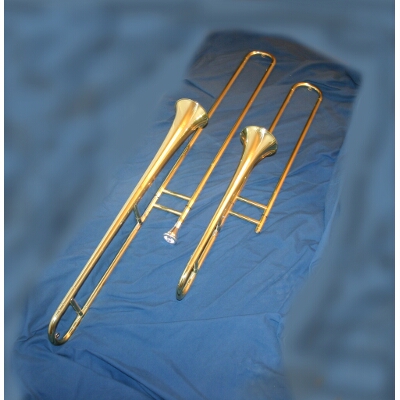
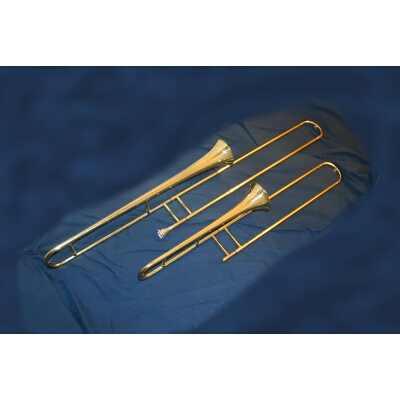 Alto and tenor sackbuts for comparison.
These are not copies of historical instruments.
Note that they have two stays on the bell section, tubualer stays, and lack garlands.
Alto and tenor sackbuts for comparison.
These are not copies of historical instruments.
Note that they have two stays on the bell section, tubualer stays, and lack garlands.
Sackbuts were commonly used in churches to double the voice parts. During the latter half of the sixteenth century a repertory of instrumental music for consorts of sackbuts was created.


Page Design Copyright 2010 Michael Berger
Clip Art Copyright 2002 Dover Publications

